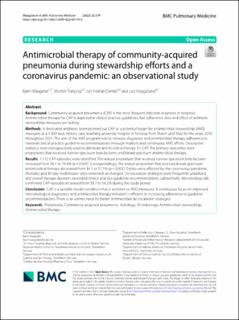| dc.contributor.author | Waagsbø, Bjørn | |
| dc.contributor.author | Tranung, Morten | |
| dc.contributor.author | Damås, Jan Kristian | |
| dc.contributor.author | Heggelund, Lars | |
| dc.date.accessioned | 2023-01-09T10:20:29Z | |
| dc.date.available | 2023-01-09T10:20:29Z | |
| dc.date.created | 2022-10-27T12:03:05Z | |
| dc.date.issued | 2022 | |
| dc.identifier.citation | BMC Pulmonary Medicine. 2022, 22:379 1-10. | en_US |
| dc.identifier.issn | 1471-2466 | |
| dc.identifier.uri | https://hdl.handle.net/11250/3041888 | |
| dc.description.abstract | Background
Community-acquired pneumonia (CAP) is the most frequent infection diagnosis in hospitals. Antimicrobial therapy for CAP is depicted in clinical practice guidelines, but adherence data and effect of antibiotic stewardship measures are lacking.
Methods
A dedicated antibiotic team pointed out CAP as a potential target for antimicrobial stewardship (AMS) measures at a 1.000-bed, tertiary care, teaching university hospital in Norway from March until May for the years 2016 throughout 2021. The aim of the AMS program was to increase diagnostic and antimicrobial therapy adherence to national clinical practice guideline recommendations through multiple and continuous AMS efforts. Descriptive statistics were retrospectively used to delineate antimicrobial therapy for CAP. The primary outcomes were proportions that received narrow-spectrum beta-lactams, and broad-spectrum antimicrobial therapy.
Results
1.112 CAP episodes were identified. The annual proportion that received narrow-spectrum beta-lactams increased from 56.1 to 74.4% (p = 0.045). Correspondingly, the annual proportion that received broad-spectrum antimicrobial therapy decreased from 34.1 to 17.1% (p = 0.002). Trends were affected by the coronavirus pandemic. Mortality and 30-day readmission rates remained unchanged. De-escalation strategies were frequently unutilized, and overall therapy duration exceeded clinical practice guideline recommendations substantially. Microbiologically confirmed CAP episodes increased from 33.7 to 56.2% during the study period.
Conclusion
CAP is a suitable model condition that is sensitive to AMS measures. A continuous focus on improved microbiological diagnostics and antimicrobial therapy initiation is efficient in increasing adherence to guideline recommendations. There is an unmet need for better antimicrobial de-escalation strategies. | en_US |
| dc.language.iso | eng | en_US |
| dc.publisher | BioMed Central | en_US |
| dc.rights | Navngivelse 4.0 Internasjonal | * |
| dc.rights.uri | http://creativecommons.org/licenses/by/4.0/deed.no | * |
| dc.title | Antimicrobial therapy of community-acquired pneumonia during stewardship efforts and a coronavirus pandemic: an observational study | en_US |
| dc.title.alternative | Antimicrobial therapy of community-acquired pneumonia during stewardship efforts and a coronavirus pandemic: an observational study | en_US |
| dc.type | Peer reviewed | en_US |
| dc.type | Journal article | en_US |
| dc.description.version | publishedVersion | en_US |
| dc.source.pagenumber | 1-10 | en_US |
| dc.source.volume | 22 | en_US |
| dc.source.journal | BMC Pulmonary Medicine | en_US |
| dc.identifier.doi | 10.1186/s12890-022-02178-6 | |
| dc.identifier.cristin | 2065582 | |
| dc.relation.project | Norges forskningsråd: 223255 | en_US |
| dc.source.articlenumber | 379 | en_US |
| cristin.ispublished | true | |
| cristin.fulltext | original | |
| cristin.qualitycode | 1 | |

